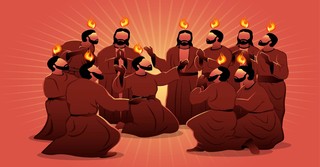8 Ways God Appears to His People in Scripture
Share

C. S. Lewis created the character of Aslan for The Chronicles of Narnia, the great Lion and Lord of the wood. Since the publication of the series, readers of various backgrounds have become enamored with the majestic Lion who offers himself in place of Edmund. The lovely mane and mighty roar. The gentle guiding, yet awesome power. And if readers reach the realization of who this Aslan really is – they find Someone equally as lovable and powerful. For Lewis developed the character after asking himself what it might look like for Jesus to enter a different world to save it.
God has revealed Himself to us in numerous ways. These appearances, referred to by scholars as theophanies, caught the attention of people in Scripture, but they also provide insights for us today about the Lord’s character. Why would He choose to show Himself, for instance, as a pillar of cloud and fire to the Israelites? He did not choose this depiction by mistake. It was intended.
So, let us take a tour of these appearances in the Bible, keeping notes of what they reveal about our Lord and His traits. We might be surprised by the contrasts we find. But taken together, these appearances show us that our Lord is a holy, powerful, and loving God who cares deeply about His people. As Mr. Beaver said about the great Lion, “he isn't safe. But he's good. He's the King, I tell you.”
Photo credit: ©Getty Images/SDenisov

1. As a Stranger
A few times in Scripture, we find the Lord showing up in unexpected places. Abraham entertained three strangers who were traveling by, which is not surprising since hospitality was a cherished value in the Ancient Near East. But what is interesting about this encounter is that right before he sees the three men, Scripture says that “The Lord appeared to Abraham near the great trees of Mamre while he was sitting at the entrance to his tent in the heat of the day” (Genesis 18:1).
When one of the men talks, he speaks the words of God, promising to Abraham and Sarah that they would have a son by the next year (Genesis 18:10). And while the other two strangers depart, one remains and it is clear that Abraham is talking to the Lord, pleading with Him to show mercy to Sodom and Gomorrah (Genesis 18:22-33). The next chapter reveals that the other two men are angels who help Lot and his family flee (Genesis 19:1, 16).
Not every biblical scholar agrees that this appearance to Abraham was a theophany. However, there are indications in the passage that one of the strangers is the Lord.
That is not the only time someone assigned a meeting with a stranger as a visitation from the Lord. When Jacob was alone at night, worried about meeting his brother the next day, a man wrestled with him (Genesis 32:24). They grappled with each other throughout the night. Yet even with his hip socket being wrenched, Jacob did not relent until the man blessed him. This stranger gave Jacob a new name: Israel, which conveys the meaning of struggling or wrestling with God (Genesis 32:28).
We are never told the man’s name, but Jacob was convinced he had seen the Lord, which is why he named the place Peniel. As he said, “It is because I saw God face to face, and yet my life was spared” (Genesis 32:30).
These encounters show us God’s faithfulness since He made a promise to Abraham at His appearing and showed great mercy in sparing Lot and his family from the destruction of Sodom and Gomorrah. In His encounter with Jacob, He humbled the deceiving brother and gave him a new identity. In both events, God appeared mysteriously as a stranger.
Photo credit: Unsplash/Ben Sweet

2. A Burning Bush
Would a flaming bush that does not burn up catch your attention?
It made Moses take a closer look. He was caring for his father-in-law’s flock on Mount Horeb when he saw the burning bush. God began speaking to him from within the flames, declaring the ground holy (Exodus 3:1-5). God revealed Himself that day as the great I AM – the God of Abraham, Isaac, and Jacob (Exodus 3:6, 14). He was sending Moses to lead the Israelites out of Egypt since He had seen their suffering and would rescue them (Exodus 3:10).
Moses only thought of his own inadequacy of leading the people, not fully taking in the scene before Him. God was talking to him from within a bush that was on fire yet not destroyed. The ground was so sacred he had to take off his sandals because he was in the presence of the Lord whose holiness was evident by the purity of the flames. This was the eternal God who always existed and always will as the I AM. If the Lord could keep a bush from being destroyed, then He could free the Israelites from slavery as He promised.
In this appearance, we are shown the great power and holiness of the Lord, but also His willingness to meet people where they are. He revealed Himself to Moses in a natural setting as Moses was working, and He consented to the fearful shepherd’s request for help when talking to Pharoah and the Israelites (see Exodus 4:10-17). This awesome God, who is greater than all, cared for His people and wanted to be known by them.
Photo credit: ©Getty Images/Apisit Suwannaka

3. A Pillar of Cloud and Fire
The Lord set the Israelites free from slavery and led them out of Egypt. He was present with them in the form of a pillar of cloud by day and a pillar of fire by night so that no matter what time of day, they could travel with Him (Exodus 13:21-22). And He continued to remain even after they had crossed the Red Sea on dry ground.
In their journey to the Promised Land, He went ahead of them and where the cloud stopped, that was where the Israelites would set up their camp (Numbers 9:17). Also, at the giving of the Law, smoke covered Mount Sinai because the Lord had descended in fire, which indicated the presence of His glory (Exodus 19:18)
From the accounts in Scripture, the appearance of the cloud and fire was deliberately chosen so the Israelites could see the Lord’s leading and presence. The image of fire already held great significance since God’s holiness was evident in the flames, just as it had been in the burning bush. What an encouragement it would have been to look up and see the great cloud or fire in the midst of the camp – God was with them!
This imagery continued to symbolize the Lord’s presence, even long after they had received the Tabernacle, and later the Temple. Whenever Moses communed with God in the Tent of Meeting or Tabernacle, the cloud would hover at the entrance (Exodus 33:9). His presence, referred to by scholars as the Shekinah Glory, was indicated by the cloud on the Mercy Seat of the Ark of the Covenant (Exodus 25:22; see also Leviticus 16:2). And when Solomon dedicated the newly built Temple, Scripture describes how the area was so filled with God’s glory that the priests could not perform their duties (1 Kings 8:10-11). God continued to dwell in the Temple until the time of Ezekiel, when the prophet witnessed the departure of the Lord’s glory (Ezekiel 10:18).
Interestingly, Ezekiel notes a future day when the cloud will return (Ezekiel 43:2-5). We also find this imagery in the book of Revelation where we are told that Jesus will return “with the clouds of heaven. And everyone will see him — even those who pierced him. And all the nations of the world will mourn for him. Yes! Amen!” (Revelation 1:7).
The imagery of the cloud, smoke, and fire all symbolize God’s holy presence and glory as He dwells with His people.
Photo credit: Unsplash/Jelleke Vanooteghem

4. A Majestic King
The top of the Ark of the Covenant, which had the wings of the cherubim overshadowing it, was known as the Mercy Seat. There, the cloud of glory appeared, and Scripture uses the terminology of a throne when referring to this seat (see 1 Samuel 4:4; 2 Samuel 6:2; 1 Chronicles 13:6; Psalm 99:1). The writer of 1 and 2 Samuel and Chronicles, may have so often emphasized how the Lord was enthroned between the two cherubim to again remind Israel of their true King – the Lord God.
Multiple places in Scripture show God appearing to His people as a majestic King. In Isaiah’s vision of the Lord, he describes how he saw God sitting on a throne surrounded by seraphim. These angels constantly worship the Lord, declaring praises. Specifically, the prophet pronounced a woe upon himself because his eyes had seen “the King, the Lord of hosts” (Isaiah 6:5). Similarly, Ezekiel described seeing God’s throne with the likeness of sapphire or lapis lazuli (Ezekiel 1:26). The Lord appeared enveloped in bright color and fire. The best way the prophet could describe the glory of God was that it looked like “a rainbow in a cloud on a rainy day” (Ezekiel 1:28 ).
Daniel also had a vision of the Lord during a prophetic dream he received about the future. He described the Ancient of Days as appearing with white clothing and hair, and a throne flaming with fire (Daniel 7:9). We read a similar description in Revelation 1:14-16 when John sees Jesus in His glory. And the Apostle is shown Heaven where God sits enthroned, surrounded by a rainbow and beautiful gems – details matching Isaiah and Ezekiel’s visions (Revelation 4).
God’s beauty is evident in these passages of Scripture. We witness, along with the prophets, the wonder and majesty of the One who rules over all. The Lord is truly King and deserves all praise (Psalm 47:7).
Photo credit: ©Getty Images/Mustapha GUNNOUNI

5. The Son of Man
Out of all the appearances in Scripture, the greatest revelation of God is found in the incarnation. On the night before His crucifixion, Jesus told the disciples that anyone who had seen Him had seen the Father (John 14:9; compare to 12:45). He makes the Father known since He is the image of the invisible God and the exact representation of His being (John 1:18; Colossians 1:15; Hebrews 1:1-3). Distinct from the theophanies we find throughout the Bible, the incarnation is unique and permanent.
God the Son took on human flesh and dwelt among us (John 1:14). He did this to perfectly reveal the Father but also to relate to us. In living a human life, He knows what it is like to go hungry and thirsty, to need sleep, to be tempted, and to experience sorrow. And He identified with us by bearing our sins and bringing us redemption through His blood. He was also physically resurrected to bring us life, and the hope that we too will one day be raised in glorified bodies (1 Corinthians 15:23; Colossians 1:18). Even now, our Savior is alive in His resurrected body, fully God and fully man.
The other religions of the world tell us that we must somehow reach out and work our way to a god or gods, and even then, we might be rejected or must start over again in another life. Yet the Bible uniquely presents us with the truth that God came to us to do what we cannot – live a perfect life, pay the punishment of sin, and attain victory over sin and death. He knows our deepest pain and bought our healing through His wounds. As 1 John 4:9 says, “This is how God showed his love among us: He sent his one and only Son into the world that we might live through him.”
In Jesus, we are shown that the holy Lord is loving and full of grace.
Photo credit: ©Getty Images/kevron2001

6. A Dove
At Jesus’ baptism, the entire Godhead was present. Jesus humbly submitted to baptism as the Father expressed His pleasure with the Son. And as the Lord came up from the water, a dove descended on Him (Matthew 3:16). In the form of a bird, the Holy Spirit made a physical appearance.
This moment was important in showing that Jesus is the Christ. Isaiah had prophesied that the coming Messiah would be anointed with the Spirit of the Lord: “the Spirit of wisdom and of understanding, the Spirit of counsel and of might, the Spirit of the knowledge and fear of the Lord” (Isaiah 11:2). The dove landing on Jesus showed that He is indeed the promised King and Savior.
Also, the dove is a well-known symbol of peace and new life – a fitting representation of the Spirit who produces the fruit of peace in our lives (Galatians 5:22). When Noah sent out the dove and raven from the ark, the dove returned with an olive branch, which showed that life had returned to the earth after the destruction of the flood (Genesis 8:11). Similarly, the Holy Spirit brings about a rebirth in our lives when we place faith in Jesus (John 3:5-6; Titus 3:5). Our old selves have died, and we have been born again by the power of the Spirit of God.
Photo credit: ©Getty Images/sakepaint

7. Tongues of Fire
A bird was not the only form in which the Holy Spirit appeared. On the day of Pentecost, He appeared as tongues of fire that separated and rested on each of the believers present (Acts 2:3). They were baptized with the Holy Spirit that day, filled with His presence and power, and were enabled to speak in other languages (Acts 2:4). The fire symbolized the renewing and purifying presence of God as He brought new life.
John the Baptist had already foretold this event when he explained that he baptized with water for repentance, but that Jesus would baptize with the Holy Spirit and fire (Matthew 3:11; Luke 3:16; John 1:33). The Jewish people would have already been familiar with the Old Testament examples of God appearing in fire – such as in the burning bush and the pillar of fire. Interestingly, though, the Spirit now individually rested on the disciples, showing that He was baptizing them, empowering them for service, and residing within them. For as Jesus said, the Holy Spirit would live with them (John 14:16-17). That promise applies to every believer.
The image of the tongues also correlated with the power that the Holy Spirit gave the disciples to speak in other languages (Acts 2:5-12). Many theologians and scholars view this event as a reversal of Babel (Genesis 11:1-9). Instead of confusion, God had enabled the disciples to speak about the good news in a way that people of various nationalities could understand. The gift of the Spirit not only impacted them as individuals but also brought blessings to others.
Photo credit: ©Getty Images/Andry Djumantara

8. A Lamb
In The Voyage of the Dawn Treader, Aslan appears as the majestic Lion, but also as a Lamb. C. S. Lewis likely thought of Revelation 5 when including this appearance because in John’s vision of Heaven, he described the Lion of Judah directly before seeing a Lamb at the center of the throne (Revelation 5:5). This was not the fluffy animal that we normally think of, but a Lamb that looked as if it had been slain (Revelation 5:6; compare to Isaiah 53:7).
John similarly described Jesus using the image of a Lamb in his Gospel. When John the Baptist had seen the Lord, he declared that Jesus is the Lamb of God (John 1:29). The Passover lamb was sacrificed without breaking any bones, and its blood was used to cover the doorways of the Israelite homes to protect them from the destroying angel. In the same way, Jesus died on the cross without any broken bones (Exodus 12:46; John 19:36). His blood covers us and atones for our sins (1 John 1:7).
At the center of all of Heaven’s worship was not a symbol of power or force. Rather, John saw the humble and lowly figure of a slain Lamb. This is God the Son whom we praise and give all glory to, because He is the One who laid down His life to save us. He is our King and Lord. As the angels and elders in Heaven sang, “Worthy is the Lamb, who was slain, to receive power and wealth and wisdom and strength and honor and glory and praise!” (Revelation 5:12).
Our God shows us that it is by sacrifice, not by might, that we overcome. That love is stronger than evil. And that the greatest of all is the One who willingly gave up His life for those who are undeserving.
May our lives bend in rhythm to the praises of Heaven – the Lamb alone is worthy!
Source
Lewis, C. S. Letters to Children. Edited by Lyle W. Dorsett and Marjorie Lamp Mead, Macmillan, 1985, 45.
Photo credit: ©Getty Images/Filip_Krstic
